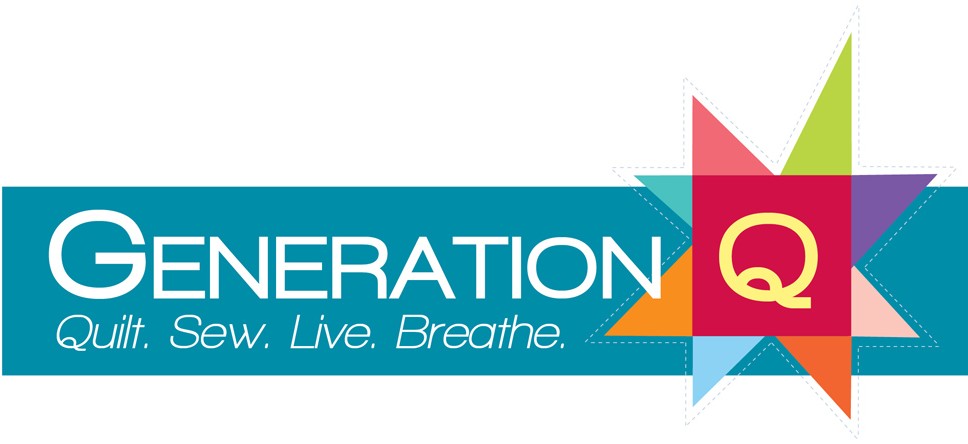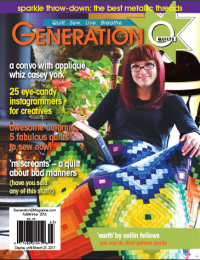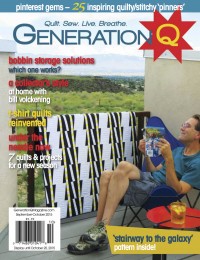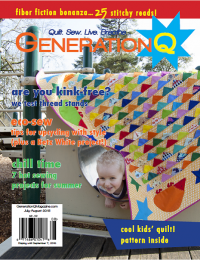 Last week we admittedly stirred the pot a bit when we posted about the phenomenally boneheaded editorial (we get to say this because we aren’t a newspaper) published in the Nov. 15 edition of the Chattanooga Times Free-Press. This staff-written, anonymous editorial (which means it meets with at least some management approval) made the argument that public funding “given” to a world-renowned quilt-themed museum was inappropriate, in part because quilts “have become largely irrelevant in modern culture.”
Last week we admittedly stirred the pot a bit when we posted about the phenomenally boneheaded editorial (we get to say this because we aren’t a newspaper) published in the Nov. 15 edition of the Chattanooga Times Free-Press. This staff-written, anonymous editorial (which means it meets with at least some management approval) made the argument that public funding “given” to a world-renowned quilt-themed museum was inappropriate, in part because quilts “have become largely irrelevant in modern culture.”
Yep. We know. And really, we’re not here today trying to stir this stew of factual inaccuracies and poor research any more than we—and you all—already have. (For those of you new to this rant, we’re not enraged over the topic of public funding for museums, only the lack of cursory knowledge and the patronizing, demeaning and ignorant tone offered by the author towards quilters.)
Instead, what we want to do is grab a few moments of your time and introduce you to one of the Seven Wonders of the Q-niverse: The International Quilt Study Center & Museum in Lincoln, Nebraska.
This offshoot of the University of Nebraska, Lincoln, supports the school’s longstanding Department of Textiles, Merchandising & Fashion Design, and provides the only Quilt Studies graduate program in the world. Students earning a degree in Quilt Studies go on to serve as curators, researchers and historians in the museum, gallery and textile worlds, says Dr. Patricia Crews, director of the IQSC.
“We have grown rapidly from a vision to an academic center with a collection to a museum” Crews says. “When we were merely an academic study center, we welcomed several thousand visitors a year. Since opening as a museum in 2008, more than 80,000 people have visited the museum. We have had visitors from every state and more than 30 countries. It’s pretty remarkable.”
The center was created because of the incredible gift of what is considered one of the largest collections of quilts held in private hands.
Ardis and Robert James were first bitten by the quilt-bug in 1979 and started collecting them aggressively. By 1997, they’d acquired more than 1,000 quilts—old and new—and donated most of them to IQSC. Because the university was equally receptive to the quilts, the IQSC was formed and the James’ collection has become the centerpiece collection of the more than 4,000 quilts now held by the IQSC. By the way, that number reflects the largest publicly held quilt collection in the world, says Laura Chapman, communications coordinator for the IQSC.
The museum offers a solid rotation of exhibits and educational talks. It shares its collections with museums from all over the globe and welcomes other exhibits into its halls.
Current museum exhibitions include World War II Quilts, Indigo Gives America the Blues and SAQA Showcase: A Studio Arts Quilts Associates Invitational.
But visitors aren’t limited to enjoying the museum’s offerings only in person. The IQSC has done a phenomenal job of posting its exhibitions and supporting materials online. A dedicated quilt-lover could spend days just lusting over the collections online. And for researchers, there’s a database with 2,800 quilts at your fingertips.
Quilts are constantly acquired for the museum’s permanent collection and many of them are made by living quilters, which Crews says is vitally important to the industry.
“We have large collection of studio art quilts and we’re beginning to build our mainstream traditional quilts. That’s been more of a challenge, to decide what to collect,” she says. “We believe if you don’t support the living makers, you won’t have a living tradition. We’re committed to supporting the living maker.”
Quilts are important because they are “rich stores of information about our culture,” says Crews.
“So why is it important to preserve any of tangible material culture? Because we can learn more about ourselves, our past and our connections around the world,” she says.
More information about the IQSC, including travel tips and links to nearby lodging and other attractions, is available on its website, www.quiltstudy.org.
Lastly, if you’re also completely enthralled by what the IQSC is doing, consider supporting them directly through a membership. As one of our friends pointed out, if even some of us pitched in with an annual membership, public funds would not be needed by the IQSC.
Oh, and because we were just blown away, we do want to shout out one of the many, many comments that came our way defending the IQSC and quilting in general. Lauren, whose comment is below, gave a thoughtful, well-documented argument about the value of museums and the support they receive. We just had to reprint it here:
“There have been many wonderful comments about quilts, the purpose they serve, and the quilt industry in general. I am also a quilter and agree with most of what has been said. I am also a person who believes in the arts and the importance that they play in both education and history. I would like to address the museum side of the discussion.
“If the editor had done his homework, he would have discovered that between the years of 2008-2012, the U.S. Federal Government gave $821,343,657.00 in federal grants to museums and libraries (which averages out to about $170,268,731.00 per year). Puerto Rico, Samoa, Northern Marianas, Guam and the U.S. Virgin Islands were among the recipients. They allocate this in the budget and someone will receive the money. It is not as though they are taking away from something else…it is part of the Federal Budget. Many museums and libraries could not exist without the government’s assistance. So, unless Congress cuts the budget for the ‘Institute of Museum and Library Services’ there will be grants for museums, many of which we will never visit.
“Of that amount Tennessee received between $16,341,001.00 ($3,268,200.00 average per year), and Nebraska received a whopping $7,025,322.00 ($1,405,064.00 average per year). Tennessee received more than double the monies of Nebraska.
“The small amount that IQSC received did not in any way affect the citizens of Tennessee. The citizens of Nebraska could argue the same point of the arrogant and narrow-minded editor of The Chattanooga Times Free Press, because they, most likely, will never visit the museums and libraries in Tennessee.
“In 1966 Mike Wallace categorized museums into four distinct types: national museums that hold collections of national importance, armed service museums, independent museums and local authority museums. Wallace said, ‘The importance of museums lies in their role as a nation’s memory bank.’ Museums are our only source of ‘living history.’ IQSC is not a local museum, but a national one, preserving our past and teaching us about the future.
“Quilters are not the only ones that benefit from IQSC in Nebraska and the National Quilt Museum in Paducah; but because of their existence, our future generations will have a look at the past to learn from.
“If you have never been to the Smithsonian, then you may not know that it is 100 percent free to the public. There are 19 museums that make up the Smithsonian. Why shouldn’t federal money help preserve our past and future and help fund our museums? I would much rather my tax dollars go to a museum, than to an unnecessary war.
“A wise person once said, ‘You can’t tell where you are going, unless you know where you have been.’
Now celebrate your day by finding just 10 minutes to do some stitching. And then book your trip to Lincoln, Nebraska!








COMMENT #1
Thanks for bringing this stupid editorial to light. Several years ago, similar arguments were made in the Nebraska legislature by people trying to block construction of the museum in the first place. Fortunately they failed. I just wonder what Neanderthal organization is circulating these “facts” for stupid editorial writers to pick up on. (You know the editorial writer in Chattanooga didn’t do all this research himself.)
I couldn’t help but notice that all the comments left by quilt supporters on the newspaper website were literate, grammatical and polite. What a change from the usual comments on newspaper websites! We are truly a nicer bunch of people than a lot of other demographic slices you could name.